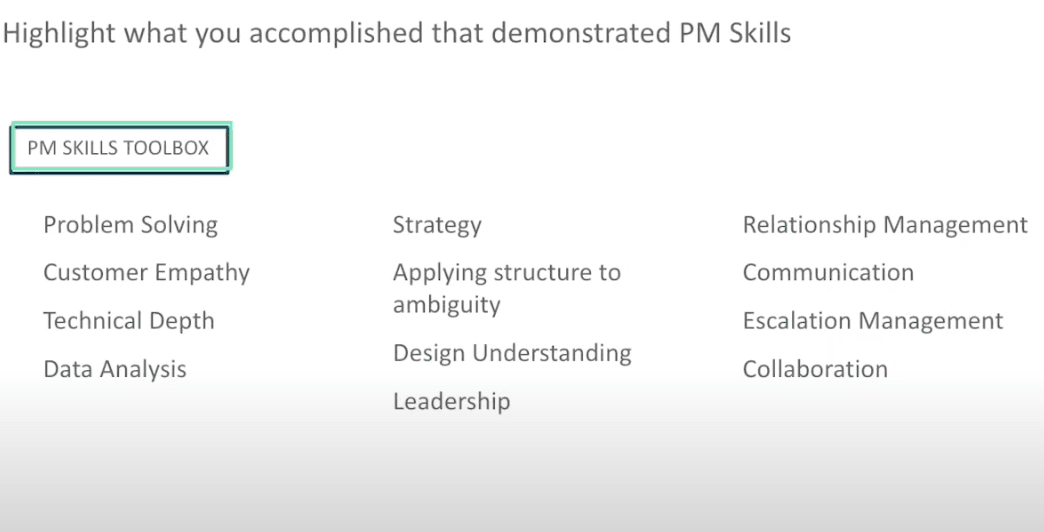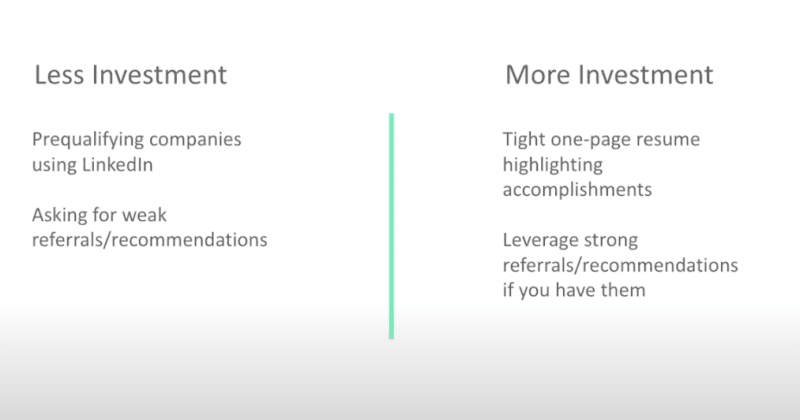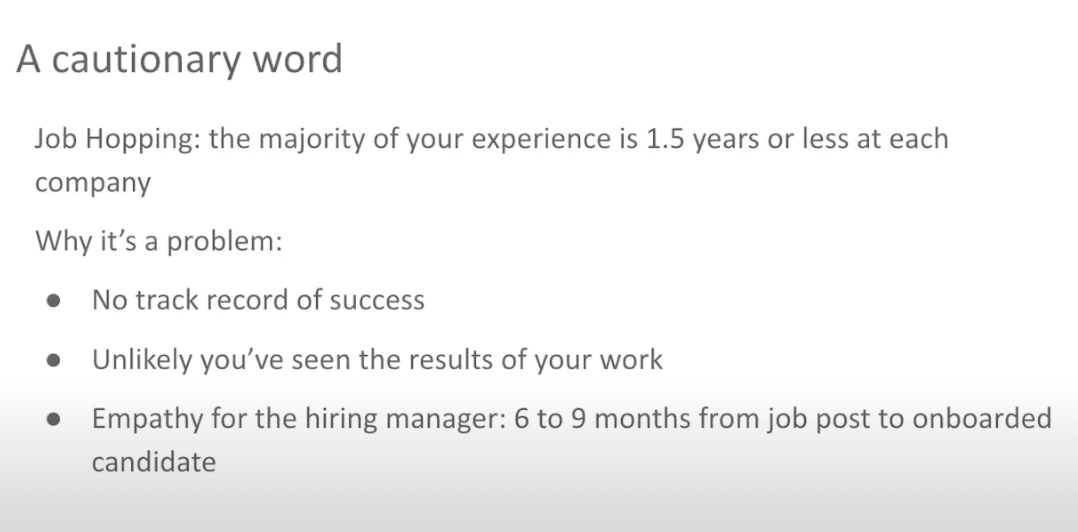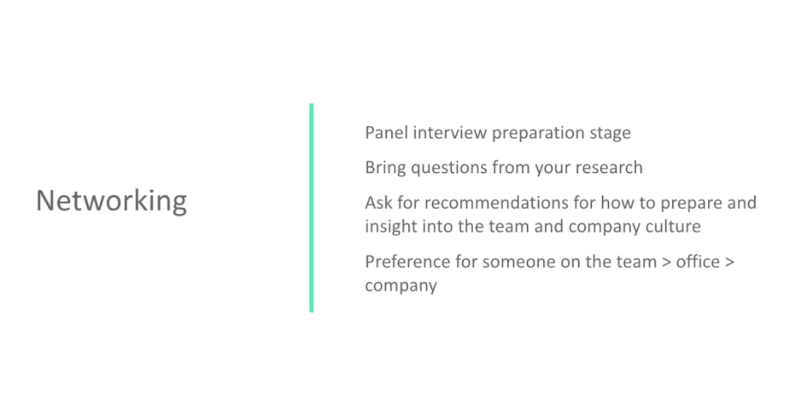Updated: January 24, 2024- 16 min read
Looking to score your first Product Management job or level up in your current role? A whirlwind of questions might be swirling around in your mind. From understanding how to land that coveted first PM role to optimizing your application for maximum impact, there's a lot to navigate.
Editorial note: This post is based on a talk by Elaine Perez, Square Sr PM, on FAQs about Landing a Product Management Job and contains additional insights and examples from the Product School team. You can watch the webinar in full above.
In this guide, we'll dissect strategies to secure your first Product Management job, expert tips to make your application truly stand out, essential areas to focus on while prepping for interviews, and any training requirements you might (or not) need.
Tips and tricks for Product newbies
How do you set your foot through the door, especially if you're a newcomer? Let's unwrap some strategies to give you a head start.

Immerse yourself in learning
Begin by immersing yourself in everything PM. Books, blogs, podcasts. Seek advice from mentors, engage with seasoned PMs, and ask about the resources that shaped their journey. Building a solid knowledge foundation will help you be better equipped.
Highlight and harness your PM-aligned Skills
Your resumé is your first impression. Instead of merely listing your experiences, align them with quintessential PM skills: problem-solving, customer empathy, strategy, leadership, and communication. For every bullet point on your resumé, ask yourself, "How does this showcase a core PM trait?" By doing so, you'll ensure your achievements resonate with what hiring managers are looking for, setting you up for success in subsequent interview stages.

Broaden your horizons
Diversity in backgrounds is a boon in Product Management. Whether you're transitioning from engineering, customer success, product marketing, or entrepreneurship, there's always a unique perspective you bring to the table.
If you're eyeing an entry into product management without direct experience, consider joining a startup. These environments often present opportunities to wear multiple hats, giving you the perfect platform to showcase your potential.
Be proactive
And remember, it's a numbers game. The application process can be seen as a conversion funnel. To maximize your chances, be proactive. Apply to roles that align with your experience but also don't shy away from those slightly out of your comfort zone. Large corporations often have multiple roles open; apply to all that seem a good fit. Just ensure that you're consistent in the kind of roles you're applying for to avoid sending mixed signals.
Don’t take rejection personally
Finally, a note on rejection: it's never personal. Sometimes, circumstances beyond your control can influence hiring decisions. Perhaps an offer was extended to another candidate before your interview. Or maybe the role requirements changed midway. Regardless of the reason, remember that every interview is an opportunity—to learn, to network, and to get closer to your dream PM role.
Make your application shine: Where to invest and where to save
Knowing where to focus your efforts and where to pull back can make all the difference when you’re applying for a job. Here are some areas where you might consider scaling back and others where you might dive in deeper to ensure your application truly stands out.

Less Investment
1. Over-Engaging on LinkedIn
While LinkedIn can be an excellent platform for networking, it's essential to use it strategically. For example, reaching out to every potential employer or manager may not be the best use of your time. Why? While a quick chat may provide you with some insight, it doesn't necessarily bring you closer to the interview table. Remember the conversion funnel analogy?
Engaging deeply at the very top might mean exerting energy on roles that might not even reach the interview phase. Instead, streamline your focus to specific roles and industries you're genuinely interested in.
2. Seeking weak referrals
Referrals can indeed open doors, but only when they carry weight. A casual chat with someone you've just met on LinkedIn, followed by a request for a referral, isn't the golden ticket you might think it is. Such referrals, given without a strong basis or a real professional relationship, are often seen as weak. They might not hold significant sway during the hiring process. Instead of seeking quantity in referrals, prioritize quality. Connect with professionals with whom you have a genuine rapport or past working relationship. Their words will undoubtedly carry more weight.
More investment
The next steps in ensuring your application stands out lie in the details. Often, the difference between a glance and a double-take is in the nuances of your presentation. Here's where to direct more of your energy and effort:
1. Craft an outstanding resumé:
Your resumé is often the first impression a potential employer gets of you. Therefore, it needs to be crisp, clear, and concise. Here's how:
Keep it tight
Aim for a one-page resumé, especially if you're in the early or mid stages of your career. Being concise doesn't mean omitting vital details, but presenting them succinctly. Ensure that your formatting is consistent and that there are no typographical errors. A polished resumé speaks volumes about your attention to detail.
Prioritize Relevance
Your rich experience in marketing or any other field is indeed valuable. However, it's essential to filter out what's most pertinent to the role you're applying for. For areas that are less relevant, consider summarizing them in a line or two, indicating that more details are available upon request.
2. Highlight your achievements
It's time to shine a light on what you've accomplished rather than just what you were responsible for. Here's the difference:
Achievements over duties
Instead of merely listing out job responsibilities (which most PMs might have in common), focus on specific achievements. Did you boost conversions by a notable margin? Maybe you initiated a product feature that drove significant user engagement? Or perhaps you led a cross-functional team to launch a product ahead of schedule? These are the stories that will make you stand out.
Quantify when possible
Numbers provide a clear picture. Saying "increased user engagement" is good, but "boosted user engagement by 25% in Q4" is better. Wherever you can, provide metrics that quantify your accomplishments.
3. Strong referrals are golden
While you might not always have them, strong referrals can provide a significant boost to your application. These are not just any referrals, but those from individuals:
Within the company
A referral from someone currently working in the company you're applying to carries more weight. It indicates an inside vote of confidence.
With whom you've worked closely
Referrals from colleagues or supervisors who've seen your work firsthand and can vouch for your capabilities and fit for the role are also invaluable.
Cautionary Word: The perils of job hopping
Navigating the professional world of Product Management demands strategy. One area where you should proceed with caution? Job hopping. This term refers to moving from one job to another within short time frames, and while it might seem like an effective strategy to gather varied experiences or climb the ladder faster, it has its downsides.

1. Absence of a clear success record
Long stints at a company often translate to valuable experience and the company's continued faith in an employee's potential.
On the flip side, if your resumé indicates fleeting engagements, it’s hard to know whether you were truly valued or effective in your roles.
2. Missing the big picture of your contributions
Product management isn't just about making decisions; it's about witnessing the ripple effect of those choices. If you’re perpetually on the move, chances are, you’re missing out on observing the full lifecycle and impact of your decisions.
And in a role as pivotal as product management, seeing a product or feature mature, adapt, and possibly pivot based on user feedback and changing dynamics is crucial. This feedback loop not only validates your decisions but also provides learning opportunities for future endeavors.
3. Think like a hiring manager
Here's a perspective switch: Imagine you're on the other side of the table. As a hiring manager, every new recruit isn't just a new team member but an investment of time, resources, and company culture.
The recruitment process is lengthy and arduous. From creating the job profile, sourcing candidates, and conducting interviews, to onboarding – it's a significant commitment. If a candidate’s history suggests they might leave before truly adding value or even fully integrating into the team, it's a risky gamble.
Preparing for an interview: The master guide
Landing that interview can be exhilarating, but then the nerves kick in, right? Here’s a comprehensive guide to ensure you’re not just prepared, but ahead of the curve when it comes to interviewing for a product management job.

Let's break it down, phase by phase.
1. Recruiter Screen
Do your homework: Before this call, ensure you've thoroughly researched the company, its products, and its recent news or accomplishments. This will give you an edge when discussing your motivation and alignment with the company's mission and values.
Master your elevator pitch: Be ready to walk through your resumé. Highlight key achievements, the challenges you faced, and the results you drove. But remember, brevity is key.
Prepare for behavioral questions: Though it's an initial screen, sometimes recruiters ask general behavioral questions. Have a few stories ready that demonstrate your soft skills, like teamwork or overcoming challenges.
2. Hiring Manager
Deep dive into the company: By this stage, your knowledge about the company should be extensive. Understand the product line, the market position, key competitors, and any recent strategic shifts or announcements.
Master the STAR Technique: For those behavioral questions, use the Situation, Task, Action, Result (STAR) technique. This ensures your answers are structured and compelling.
Ask thoughtful questions: This is a two-way street. Ask questions that show your strategic thinking, such as, "How does the team prioritize features for the product roadmap?"
3. Panel
Know your PM frameworks: Be it prioritization matrices, product life cycle models, or the lean startup method – be ready to discuss frameworks that have guided your decision-making.
Industry metrics: Understand key metrics specific to the industry you're interviewing for. Metrics like ARR and MRR for SaaS, or CAC and LTV for consumer apps, can often come up.
Engage with everyone: Remember, every panelist is evaluating your fit. Engage actively with each of them, maintaining eye contact, nodding, and acknowledging their questions.
Prepare for case studies: If you can, find out beforehand the type of products the company prioritizes. Tailor your prep accordingly. For instance, if it's a SaaS company, be ready to discuss topics like user retention, feature adoption, and churn.
Leverage LinkedIn smartly: Use your network to gain insights about the interview process, the company culture, or even the panelists you might encounter.
4. Exercise
Focus on the problem: Before jumping to solutions, make sure you’ve thoroughly understood the problem you’re being asked to solve. Ask clarifying questions if needed.
Show your work: It’s not just about the final recommendation. Outline your thought process, the data or assumptions you're working with, and the trade-offs you considered.
Exceed expectations: If a company gives you a guideline on time, remember it’s just that - a guideline. If you genuinely believe that investing a bit more time will elevate your deliverable, go for it.
Seek feedback: If given an opportunity, ask for feedback on the exercise. This showcases your openness to learn and grow.
Calibration is key: Remember, you're being benchmarked against other candidates. Ensure your output not only answers the exercise's requirements but stands out in terms of insight, clarity, and innovation.
Interview preparation best practices
How you practice can make a world of difference. Let's explore some best practices.
Dos
Mastering the difficult conversations: Whether discussing weaknesses, conflicts, or failures, strike the right tone. Position these experiences as opportunities for growth and learning, rather than points of contention.
Ditch the jargon: Ensure clarity in communication. Cut out acronyms and industry-specific terminology that might be unfamiliar to your listener. Clarity is key.
Comfort equals confidence: The more you practice, the more at ease you'll be. This comfort translates to confidence, which will shine through in the conversation.
Don'ts
Avoid memorization: Being prepared doesn't mean delivering rehearsed monologues. Overly scripted answers can come across as insincere and robotic. Focus on understanding and communicating the essence of your experiences rather than rote repetition.
No room for negativity: Tread cautiously when discussing previous roles or colleagues. Even if you face challenges, frame them in a constructive manner. Avoid pointing fingers or laying blame. Share what you've learned rather than what went wrong.
Accountability is attractive: If asked about conflicts or challenges, ensure you reflect on your role in the situation. Passing the buck or portraying yourself as the perpetual victim can be a red flag for interviewers.
Unlocking the power of LinkedIn for career advancement
LinkedIn, often perceived merely as a digital resumé, is so much more. It's a dynamic platform to network, gain insights, and foster relationships that can significantly influence your career trajectory. When you're deep into the interview process, especially the panel round, tapping into your LinkedIn connections can be a game-changer.

Why LinkedIn Networking?
Inside insights: While the internet is awash with information about companies, insights from someone 'inside' can offer a unique perspective. They can paint a more accurate picture of the day-to-day operations, the culture, and even specific details about teams or projects.
Tailored preparation: With information gained from these connections, you can tailor your preparation. Rather than generic answers, you can provide solutions and ideas that resonate more with the company's current state and direction.
Break the ice: Having a contact in the company can serve as a conversation starter. "I had a chat with [Name], who mentioned the fantastic team culture here." Such mentions can help bridge the gap between being an outsider and someone with a preliminary understanding of the company's ecosystem.
How to leverage insights from LinkedIn?
Crafting the right questions: Your objective is clarity. Whether it's ambiguities in the company's products, specific roles, or larger cultural themes, ask questions to uncover information that can't be easily googled.
Seek recommendations: A simple question like, "How can I best prepare for the interview?" can yield gold. You might get insights into the kind of questions usually posed, the formats preferred, or even the personality types that thrive in the company.
Prioritize contacts: While a connection in the exact team you're interviewing for is ideal, broaden your net if that's not feasible. Contacts in the same office location or even just in the same company can be incredibly insightful.
Turn the tables: Evaluating your potential employer
In the heat of interview preparation and acing those challenging questions, it's easy to forget one fundamental thing: this interview is a two-way street. While they're evaluating your fit for the role and the company, it's equally essential for you to assess if the company aligns with what you're looking for in your next career move.

Here’s how to make sure you’re picking the right workplace for you:
Dive deep with questions: The preliminary discussions you have before panel interviews can be instrumental. Use this time to ask hard-hitting questions. Curious about work-life balance or the company's stance on remote work? Now's the time to bring those queries to the table. Yes, you want to maintain professionalism, but remember: that genuine questions reflect genuine interest.
Stay true to your values: It’s easy to get swayed by brand names or lucrative offers, but what truly matters is alignment with your core values. If a healthy work culture ranks high on your priority list and you spot red flags suggesting otherwise, don't compromise. Remember, short-term benefits can lead to long-term dissatisfaction.
Watch out for red flags: Interviews offer a sneak peek into a company's organizational behavior. Disorganized panel interviews, distracted interviewers, or a lack of punctuality can indicate deeper underlying issues. Pay attention to these subtle cues; they're telling you what it's like to work there every day.
Bow out gracefully, if needed: There’s no harm in retracting from the process if you believe it's not the right fit. You can do so gracefully without diving into specific reasons. Remember, your time is valuable, and it's better spent pursuing roles that align more closely with your aspirations and values.
Credentials in Product Management: A necessity or a nice-to-have?
Credentials often come up in conversation. Whether it’s the allure of an MBA from a top-tier university or a specialized PM certification, many ponder their worth. So let’s demystify this: Do you really need that extra title on your resumé to shine as a product manager?

1. Understanding hard requirements vs. preferences
While credentials like an MBA or a PM certification aren't always mandated, obtaining them can significantly elevate your chances of getting the job. Even though for the most part the job lies in your ability to execute, lead, and strategize – often sourced from experience and innate skill sets – certifications can distinguish you in the crowded field, giving you a distinct edge when vying for your desired position.
2. Evaluating cost vs. benefits
Even when there's an upfront cost in terms of time, money, and effort, the long-term benefits can be substantial. Especially when you factor in the competitive edge in the job market and the potential salary of a Product Manager. The investment in certification often pays off many times over. If you're aiming for a role or sector that values a specific credential, the decision becomes even clearer. Always think of the bigger picture and the doors that a certification can open for you.
3. Bridging knowledge gaps
Credentials should serve as a bridge to fill specific knowledge gaps. The objective is to use education to elevate your skills and expertise where you find them lacking.
For instance, at Product School, apart from the Product Manager certification, we also offer tailored certifications like the Product Leader Certification, the Product Marketing Manager Certification, or even customized training for companies. These programs are designed to enhance specific areas of product management, ensuring that you're not only qualified but also equipped with the latest industry knowledge.
Considering these certifications can be a strategic move to solidify your position in the product management field.
4. Tapping into recruitment pipelines
One undeniable advantage of certain programs is their recruitment pipelines. Renowned universities and specialized PM programs often have strong ties with top-tier companies.
Enrolling in these programs can provide you with direct access to these coveted recruiting networks. It’s always a good idea to research and connect with alumni or current students to understand the hiring background that arises from these credentials.
If you want to learn more about Product Management certifications to help you up your game, you can schedule a call now with our Admissions Team.
All of our courses are crafted by industry-leading product managers and are key to standing out as an innovative and influential Product Manager.
Updated: January 24, 2024





